Grove Hospital
Tooting Grove, SW17
Medical dates:
Medical character:
Infectious diseases. Later, general
In 1893 the Metropolitan Asylums Board purchased 22 acres of land immediately southwest of its Fountain Hospital site in Tooting as the location for its last new infectious diseases hospital.
The Grove Fever Hospital was completed in 1896 but did not open until 1899. Its entrance in Tooting Grove was opposite the entrance to the Fountain Hospital. The porter's lodge contained a waiting room and a discharge room, where patients who were leaving could bathe and change from their hospital garments to their own clothes. New patients were admitted to a reception block before being assigned to a ward. At the south side of the site, by Blackshaw Road, were eight pavilion ward blocks for scarlet fever patients. The pavilion blocks were placed so their north-south orientation maximised the amount of sunlight and air; they were linked to each other and the administration and laundry blocks by covered walkways. Each block had two floors of wards (the upper floor had its own stairway from the covered walkway). Each floor had a main ward of 20 beds, each with a window each side of it, and a small side ward of 2 beds, providing a total of 352 beds. North of the scarlet fever blocks were six single-storey isolation blocks, two of which contained four 2-bedded wards. two with two 4-bedded wards and single rooms, and the others with 6-bedded and 2-bedded wards. North of these were four ward blocks with 112 beds for diphtheria and enteric fever patients.To the east of the isolation blocks lay the administration block, with the laundry to the south of it. Staff accommodation was in several blocks at the eastern part of the site, which also contained gardens and recreation grounds. The Medical Superintendent's house was at the northwest corner of the site; the mortuary and medical education blocks were at the northeast corner.
During WW1 the Hospital was requisitioned in 1916 by the War Office and became the Grove Military Hospital with 550 beds, treating both officers and other ranks. Sections of the Hospital were designated for infectious diseases, TB of the lung, and dermatology (scabies, venereal disease). The military hospital opened in November 1916 and closed in September 1919. During its operational lifetime, it had treated 2,499 officers and 13,459 enlisted men.
In 1920 it became a fever hospital once more. In 1921 it had 537 beds. More staff accommodation was built at the southeast part of the site.
In 1930 the LCC took over administrative control of the Hospital, when it had 582 beds.
In 1932, in a landmark clinical trial, Joseph Bramhall Ellison, a physician on the staff, discovered that providing vitamin A to children with measles reduced their mortality by 58%. (The expected death rate from measles in children aged up to five years old was 8-9%. Of Ellison's trial group, 3.7% died.)
In 1935 a new Nurses' Home was built.
During WW2, as well as patients with infectious diseases, civilian air-raid casualties were admitted. Several ward blocks were damaged by bombs, which rendered 210 beds unusable. Of the remaining 406 beds, 160 of the infectious diseases beds were used by TB patients.
The Hospital joined the NHS in 1948 under the control of the Wandsworth Hospital Group as the Grove Hospital; it had 408 beds. Soon after this the Ministry of Health decided that St George's Hospital at Hyde Park Corner would be rebuilt on the Grove and Fountain Hospital sites. The Grove Hospital was requested by the Ministry to make 150 beds available to St George's Hospital patients and to place nurses' accommodation and ancillary buildings at the disposal of St George's.
In 1951 patients from St George's Hospital began to be admitted. At the same time St James' Hospital in Balham was being rebuilt, which meant the temporary closure of several wards. Staff from Balham were transferred to the Grove Hospital site to open 50 beds there for their patients. The Supplies Office for the Wandsworth Hospital Group was housed in an unused block at the Hospital.
In 1952 it was decided to discard the Hospital's own generator, which was 50 years old and reaching the end of its end of its efficient life, and to receive mains electricity from the London Electrical Board. The wards were converted from DC to AC current, although much of the Hospital remained on the old DC current, making it necessary to install a mercury arc rectifier.
By 1954 responsibility for the Grove Hospital had been transferred from the Wandsworth Hospital Group to the Board of Governors of St George's Hospital. The Grove Hospital became the Tooting branch of St George's Hospital. In 1955 it had 250 beds and, in 1957 228 beds for general and infectious diseases patients. In 1958, when it had 362 beds, the Grove Hospital was renamed St George's Hospital, Tooting Branch.
In 1960 the Hospital had 374 beds for general and infectious diseases cases, and this number had increased to 450 beds by 1975 (the St George's Hospital group had 903 beds overall).
Services grew slowly on the site and it was not until 1973 that building works for the new St George's Hospital at Tooting began in earnest.
Present status (July 2008)
Most of the Grove Hospital buildings were demolished in the 1970s, but two of the original ward blocks survive, together with some of the nurses' accommodation at the southeast part of the site.
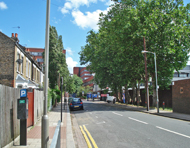
The western main vehicle entrance to St George's Hospital in Cranmer Terrace follows the original line of Tooting Grove. The Grove Hospital would have been on the right and the Fountain on the left.

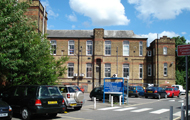
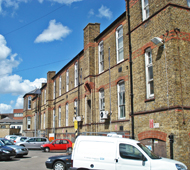
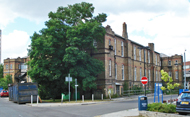
The surviving ward blocks are now the Knightsbridge Wing, used for offices, wards and out-patient clinics.

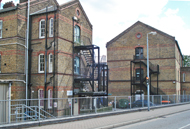
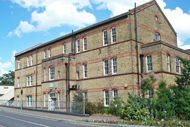
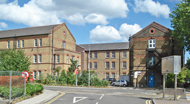
The former nurses' accommodation still exists. Bronte House and its annexe are used by the Finance Directorate of the Hospital. Clare House contains offices and a Walk-In Clinic.
(Author unstated) 1917 The Grove Military Hospital, Tooting Graveney. British Journal of Nursing, 11th August, 87-88.
Ellison JB 1932 Intensive vitamin therapy in measles. British Medical Journal 2, 708-711.
Martin WJ 1945 Mortality in childhood during 1920-38. British Medical Journal 1, 363-364.
http://archives.ucl.ac.uk
www.flickr.com
www.ribapix.com
www.sgul.ac.uk
www.stgeorges.nhs.uk
www.workhouses.org.uk
Return to home page